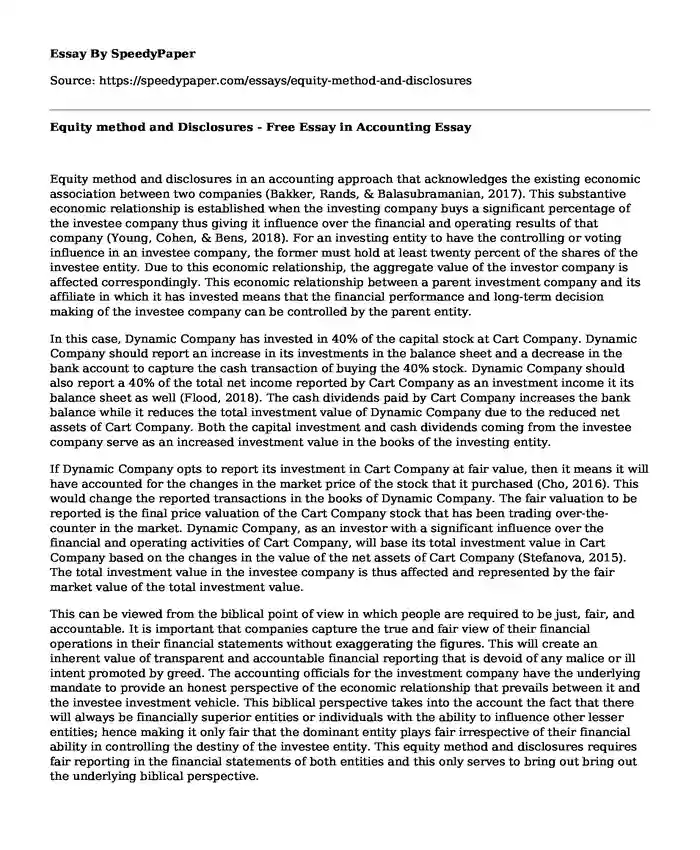
| Type of paper: | Case study |
| Categories: | Equity Accounting |
| Pages: | 3 |
| Wordcount: | 674 words |
Equity method and disclosures in an accounting approach that acknowledges the existing economic association between two companies (Bakker, Rands, & Balasubramanian, 2017). This substantive economic relationship is established when the investing company buys a significant percentage of the investee company thus giving it influence over the financial and operating results of that company (Young, Cohen, & Bens, 2018). For an investing entity to have the controlling or voting influence in an investee company, the former must hold at least twenty percent of the shares of the investee entity. Due to this economic relationship, the aggregate value of the investor company is affected correspondingly. This economic relationship between a parent investment company and its affiliate in which it has invested means that the financial performance and long-term decision making of the investee company can be controlled by the parent entity.
In this case, Dynamic Company has invested in 40% of the capital stock at Cart Company. Dynamic Company should report an increase in its investments in the balance sheet and a decrease in the bank account to capture the cash transaction of buying the 40% stock. Dynamic Company should also report a 40% of the total net income reported by Cart Company as an investment income it its balance sheet as well (Flood, 2018). The cash dividends paid by Cart Company increases the bank balance while it reduces the total investment value of Dynamic Company due to the reduced net assets of Cart Company. Both the capital investment and cash dividends coming from the investee company serve as an increased investment value in the books of the investing entity.
If Dynamic Company opts to report its investment in Cart Company at fair value, then it means it will have accounted for the changes in the market price of the stock that it purchased (Cho, 2016). This would change the reported transactions in the books of Dynamic Company. The fair valuation to be reported is the final price valuation of the Cart Company stock that has been trading over-the-counter in the market. Dynamic Company, as an investor with a significant influence over the financial and operating activities of Cart Company, will base its total investment value in Cart Company based on the changes in the value of the net assets of Cart Company (Stefanova, 2015). The total investment value in the investee company is thus affected and represented by the fair market value of the total investment value.
This can be viewed from the biblical point of view in which people are required to be just, fair, and accountable. It is important that companies capture the true and fair view of their financial operations in their financial statements without exaggerating the figures. This will create an inherent value of transparent and accountable financial reporting that is devoid of any malice or ill intent promoted by greed. The accounting officials for the investment company have the underlying mandate to provide an honest perspective of the economic relationship that prevails between it and the investee investment vehicle. This biblical perspective takes into the account the fact that there will always be financially superior entities or individuals with the ability to influence other lesser entities; hence making it only fair that the dominant entity plays fair irrespective of their financial ability in controlling the destiny of the investee entity. This equity method and disclosures requires fair reporting in the financial statements of both entities and this only serves to bring out bring out the underlying biblical perspective.
References
Bakker, E., Rands, E., & Balasubramanian, T. V. (2017). Interpretation and application of IFRS standards. Wiley Publishing.
Cho, S. (2016). Accounting and valuation guide: Valuation of privately-held-company equity securities issued as compensation. John Wiley & Sons, Inc.
Flood, J. M. (2018). Wiley GAAP 2018: Interpretation and application of generally accepted accounting principles. New York, NY: John Wiley & Sons.
Stefanova, M. (2015). Private equity accounting, investor reporting, and beyond: Advanced guide for private equity managers, institutional investors, investment professionals, and students. Upper Saddle River: Financial Times/Prentice Hall.
Young, S. D., Cohen, J., & Bens, D. A. (2018). Corporate financial reporting and analysis. Hoboken: Wiley.
Cite this page
Equity method and Disclosures - Free Essay in Accounting. (2022, Feb 22). Retrieved from https://speedypaper.com/essays/equity-method-and-disclosures
Request Removal
If you are the original author of this essay and no longer wish to have it published on the SpeedyPaper website, please click below to request its removal:
- Free Essay Example: Reducing Supplier Evaluation Cycle Time
- Free Essay with the Israel Occupied Territories Research
- HRM Essay Sample on the Relevance of Parent Company Strategies in Host Countries
- Cathode Ray Oscilloscope and Digital Storage Oscilloscope - Comparison Essay Sample
- Solar Panels Manufacturers and Environment, Free Essay Example
- Description of the patient's current status
- Free Essay on Mass Spectroscopy and Electrochemistry
Popular categories




